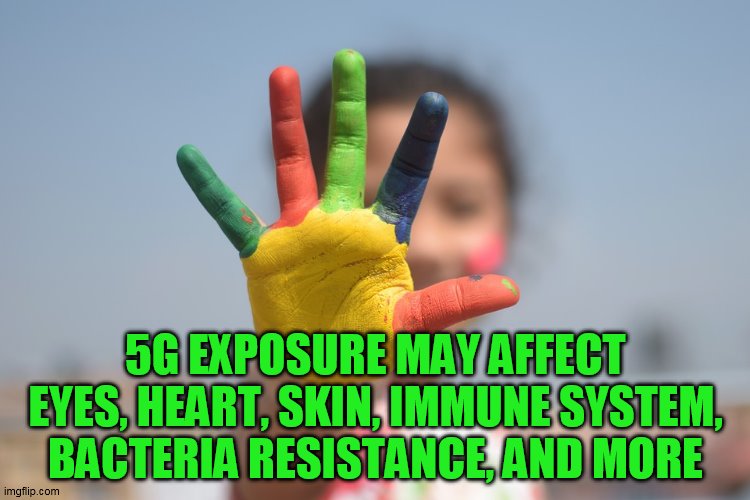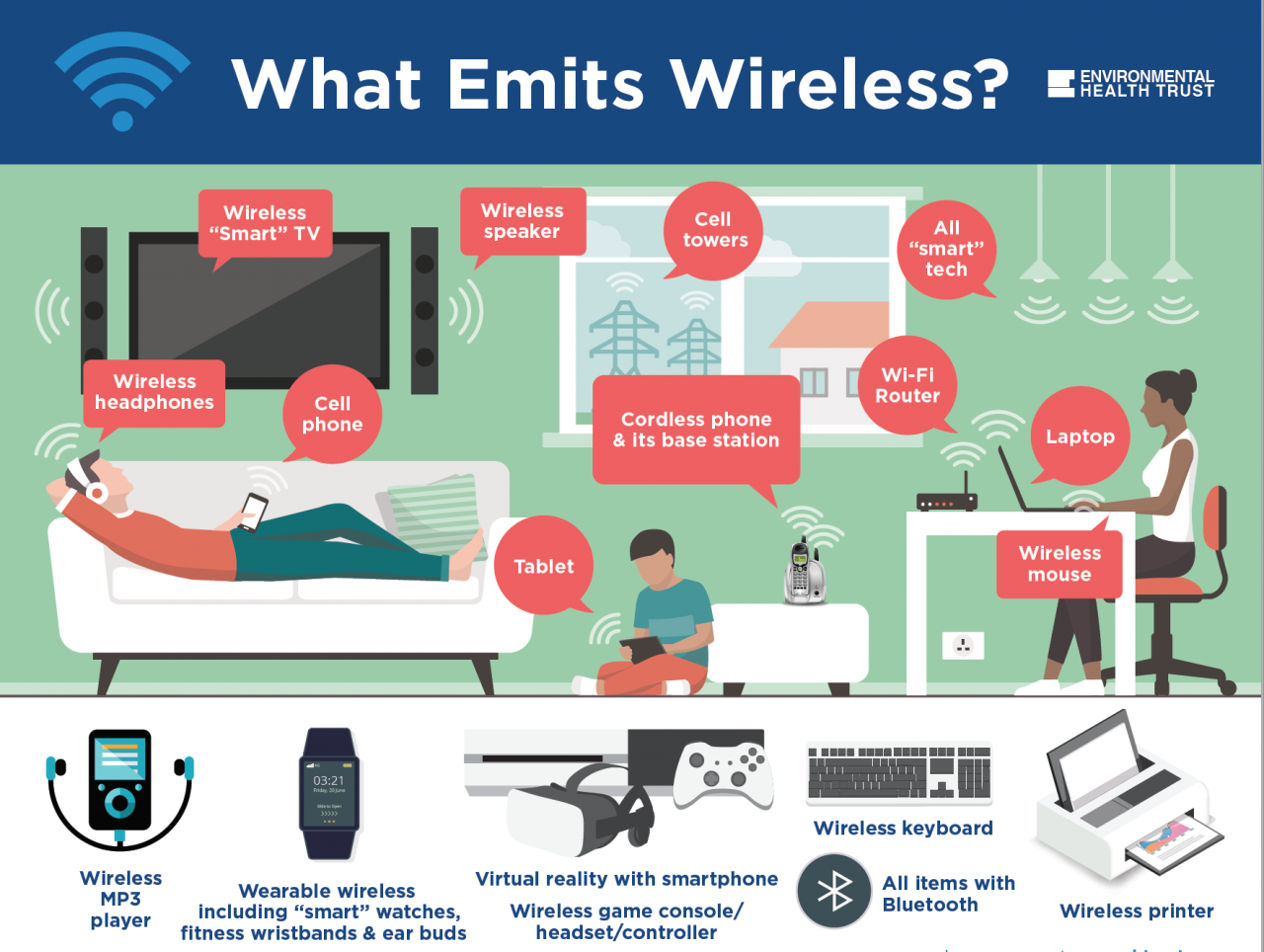 By B.N. Frank
By B.N. Frank
Decades of research has determined that exposure to Electromagnetic Fields (EMF) and Radio Frequency (RF) Radiation is biologically harmful. Children seem to be particularly vulnerable to it.
Common sources of RF radiation include “Smart” and/or wireless technology: cell phones, cell towers, personal and “Smart” home appliances, devices and, wearables (see 1, 2), utility “Smart” meters (electric, gas, and water), WiFi routers, and more.
In regard to 5G technology, there is research that has proven that exposure is NOT SAFE. The majority of scientists worldwide are opposed to deployment. Cities worldwide AND entire countries have taken action to ban, delay, halt, and limit installation AS WELL AS issue moratoriums due to health, safety, environmental and economic risks.
Where 5G hasn’t been banned – it is still being installed and turned on. Because of this, another article has been written by a medical expert requesting an immediate halt to deployment.
From Environmental Health Trust:
“Halt the 5G Rollout” Journal of Epidemiology and Community Health Article on Children and 5G
“In assessing causal evidence in environmental epidemiology, Bradford Hill himself pointed out that ‘the whole picture matters;’ he argued against prioritizing any subset of his famous nine criteria for causation. One’s overall assessment of the likelihood that an exposure causes a health condition should take into account a wide variety of evidence, including ‘biological plausibility’. After reviewing the evidence cited above, the writer, an experienced physician-epidemiologist, is convinced that RF-EMFs may well have serious human health effects.”
-John William Frank of Usher Institute, University of Edinburgh, Edinburgh, UK in the Journal of Epidemiology and Community Health entitled “Electromagnetic fields, 5G and health: what about the precautionary principle?”
A new publication in the Journal of Epidemiology and Community Health entitled “Electromagnetic fields, 5G and health: what about the precautionary principle?” by John William Frank of Usher Institute, University of Edinburgh, Edinburgh, UK concludes that “one cannot dismiss the growing health concerns about RF-EMFs, especially in an era when higher population levels of exposure are occurring widely, due to the spatially dense transmitters which 5G systems require” and Frank ” echoes the calls of others for a moratorium on the further roll-out of 5G systems globally.”
The article identifies four “relevant sources of scientific uncertainty and concern”:
- lack of clarity about precisely what technology is included in 5G;
- a rapidly accumulating body of laboratory studies documenting disruptive in vitro and in vivo effects of RF-EMFs—but one with many gaps in it;
- an almost total lack (as yet) of high-quality epidemiological studies of adverse human health effects from 5G EMF exposure specifically, but rapidly emerging epidemiological evidence of such effects from past generations of RF-EMF exposure;
- persistent allegations that some national telecommunications regulatory authorities do not base their RF-EMF safety policies on the latest science, related to unmanaged conflicts of interest.
Excerpts from the article:
“The four successive previous generations (1G, 2G, 3G and 4G) of wireless transmission systems were deployed initially for wireless and mobile phones (1980s and 1990s), followed by WiFi (2000s), and then smart metres and the Internet of Things (2010s). Each successive generation of transmission systems has used higher frequencies of electromagnetic waves to carry ever-larger volumes of data, faster, in more ubiquitous locations. 5G is widely acknowledged to be a step change in this sequence, since it additionally uses much higher frequency (3 to 300 GHz) radio waves than in the past. 5G will also make use of very new—and thus relatively unevaluated, in terms of safety—supportive technology (including pulsing, beaming, phased arrays and massive input/ massive output (MIMO)—see below) to enable this higher data transmission capacity.”
“Some countries have lowered allowable RF-EMF exposure levels far below those permitted in the UK and USA. Powerwatch, a non-profit, independent organisation in the UK, has published comparisons of international recommendations on permitted maximum exposure levels to EMFs.22 Those comparisons show that the highest permitted RF-EMF exposures which are used globally, as the basis for national safety guidelines, are those used in the USA, the UK and most of the EU.”
“These recent reviews of laboratory (ie, non-epidemiological) studies of the biological effects of RF-EMFs do identify diverse, multibody system effects, operating by a range of physicochemical pathways which are not mediated by thermogenesis. The reviewers document a growing body of evidence that RF-EMF exposures produce effects spanning reproductive/teratogenic, oncological, neuropsychiatric, skin, eye and immunological body systems. In addition, there are many fundamental effects at the subcellular level, in terms of oxidation, DNA alteration, gene expression and bacterial antibiotic resistance.”
“Persistent allegations of unscientific bases for existing health protection guidelines on RF-EMFs and unmanaged conflicts of interest on expert advisory panels.”
Frank JW, Electromagnetic fields, 5G and health: what about the precautionary principle? J Epidemiol Community Health Published Online First: 19 January 2021. doi: 10.1136/jech-2019-213595
About John Frank MD
John Frank MD, CCFP, MSc, FRCPC, FCAHS, FFPH, FRSE, LLD is Chair, Public Health Research and Policy of Usher Institute of Population Health Sciences and Informatics, University of Edinburgh
His most recent papers include:
- Frank JW, Pagliari C, Geubbels E, Mtenga S. New forms of data for understanding LMIC health inequalities: the case of Tanzania. Journal of Global Health Dec 2018; 8(2):020302 doi:10.7189/jogh 08.020302.
- McAteer J, Frank JW, Di Ruggiero E, Fraser A. Bridging the gap between public health research and policy/practice: Lessons from Canada, Scotland and rUK. Journal of Public Health 2018 doi:10/1093/pubmed/fdy127.
- Sher J, Doi L, Frank JW. Non-scientific factors influencing public health policies: Three case studies from Scotland. Journal of Public Health 2018 doi:10.1093/pubmed/fdy131.
- Brown J, Katikireddi SV, Leyland AH, McQuaid RW, Frank J, Mackay D, et al. Age, health and other factors associated with return to work for those engaging with a welfare-to-work initiative: A cohort study of administrative data from the UK’s Work Programme. In press, BMJ Open 2018;8:e024938. doi:10.1136/bmjopen-2018-024938.
- Blair A, Siddiqi A, Frank J. A Canadian report card on investments in health equity over the life-course: Analysis of time-trends and cross-national comparisons with the United Kingdom.Soc Sci Med Population Health 2018;6:158-168. https://doi.org/10.1016/j.ssmph.2018.09.009
- Inglis G,Archibald D, Doi l, Laird Y, Malden S, Marryat L, McAteer J, Pringle J, Frank JW. Credibility of of sub-group analyses by socioeconomic status in public health intervention evaluations: an underappreciated problem? Soc Sci Med Population Health 2018; 6:245-251. https://doi.org/10.1016/j.ssmph.2018.09.010.
- Williams AJ, Henley W, Frank J. Interrupted time series evaluation of the impact of abolishing prescription fees in Scotland on hospital admissions and prescriptions. In press, BMJ Open2018.
- Cote P, Frank JW, et al. Evidence-based whiplash treatment compared to usual care: a randomized control trial in a motor vehicle accident insurance system. In press, BMJ Open 2018.
- Marryat L, Frank J. The prevalence of Adverse Childhood Experiences in the general population of Scottish children in the first eight years of life. BMJ Pediatrics Open 2019; 3:e000340. doi:10.1136/bmjpo-2018-000340 .
- Blair A, Marryat L, Frank J. How community resources mitigate the effect of household poverty on childhood experiences: results from a nationally representative sample of Scottish children. In press, International Journal of Public Health 2019; May 28. doi: 10.1007/s00038-019-01258-5. [Epub ahead of print].
- Oppong-Nkrumah O., Kaufman J.S., Heymann J., Frank J. & Nandi A. The impact of increasing the minimum legal age for work on school attendance in low- and middle-income countries. SSM – Population Health 2019, doi: https://doi.org/10.1016/j.ssmph.2019.100426
- Marryat L, Wood R, Whittaker A, Frank J, Boardman J. Developing a new cohort of children born to women who used opioids in pregnancy using administrative data: insights into cohort creation and early results. International Journal of Population Data Science. 2019 Nov 22;4(3).
- Fisher S, Bennett C, Hennessy D, Robertson T, Leyland A, Taljaard M, Sanmartin C, Jha P, Frank J, Tu JV, Rosella LC, Wang J, Tait C, Manuel DG. International population-based health surveys linked to outcome data: A new resource for public health and epidemiology. Health Reports 2020 Jul 29;31(7):12-23. doi: 10.25318/82-003-x202000700002-eng
- Doi L, Williams AJ, Marryat L, Frank JW. High maternal body mass index and the risk of adverse pregnancy, delivery and neonatal outcomes: an all-of Scotland study. BMJ Open 2020 (Feb 1); 10(2): 1-9 http://dx.doi.org/10.1136/bmjopen-2018-026168
- Buajitti E, Frank J, Watson T, Kornas K, Rosella LC. Changing relative and absolute socioeconomic health inequalities in Ontario, Canada: A population-based cohort study of adult premature mortality, 1992 to 2017. PlOS One. 2020 Apr 2;15(4):e0230684.
- Anderson G, Frank JW, Naylor CD, Wodchis W, Feng P. Using a socioeconomics to counter health disparities arising from the COVID-19 pandemic. BMJ 2020;369:m2149 doi: 10.1136/bmj.m2149 (Published 8 June 2020).
- Frank J, Abel T, Campostrini S, Cook S, Lin VK, McQueen DV. The social determinants of health: time to re-think? Internat J Env Res and Public Health https://doi.org/10.3390/ijerph17165856 (doi: 10.3390/ijerph 17165856) — published online, August 7, 2020.
- Frank J, Williams AJ. A simple tool for comparing benefits and ‘costs’ of COVID-19 exit strategies. Public Health 2020 Nov 1; 188:4-7.
- Frank JW, Matsunaga E. National monitoring systems for health inequalities by socioeconomic status – an OECD snapshot. Critical Public Health Dec. 2020 DOI: 10.1080/09581596.2020.1862761
- Frank JW. 5G, electromagnetic fields and health: What about the precautionary principle? In press, JECH, December, 2020.
- Frank, J. & Geddes, R. A Public Health Perspective on Child Development – and on Scotland’s Approach to Assessment at P1. 30 Oct 2020, in: Play is the Way: Child Development, Early Years and the Future of Scottish Education. Palmer, S. (ed.). Paisley, UK: CCWB Press, Paisley UK PA3 4DA, p. 156-171.
News coverage
Expert urges to stop 5G networks until people’s safety is confirmed
Emily Henderson, News-Medical.net, Jan 19, 2021
Expert: Stop Global Roll Out of 5G Networks Until Safety Is Confirmed
Transmitter density means greater population exposure to high levels of radio frequency electromagnetic fields. We should err on the side of caution and stop the … Continue reading Expert: Stop Global Roll Out of 5G Networks Until Safety Is Confirmed
Activist Post reports regularly about 5G and other unsafe technology. For more details visit our archives and the following websites:
- Electromagnetic Radiation Safety
- Environmental Health Trust
- Physicians for Safe Technology
- Wireless Information Network
- 5GCrisis
- 5GFree
- 5G Information
- 5G Space Appeal
- Stop 5G International
- The 5G Summit
- WhatIs5GInfo
Subscribe to Activist Post for truth, peace, and freedom news. Send resources to the front lines of peace and freedom HERE! Follow us on Telegram, SoMee, HIVE, Flote, Minds, MeWe, Twitter, Gab and Ruqqus.
Provide, Protect and Profit from what’s coming! Get a free issue of Counter Markets today.
